By Steven Smith
This session is an option used as a first day of tryouts for a collegiate program that requires the coach to make cuts. It allows the coach to see multiple activities on the ball examining technical ability and game play with multiple touches. The warm up through the last activity all include decision making as well and gives a quick view at the skills necessary to play at a high level.
Activity 1: Warm up Build Up
Warm-up
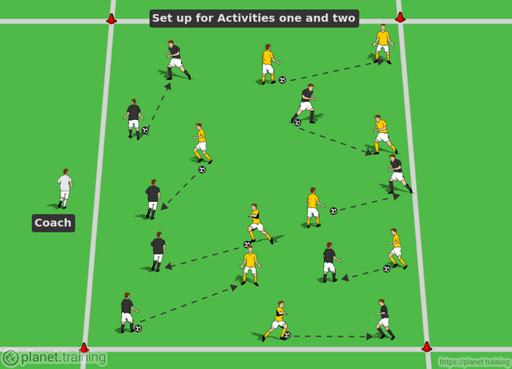
Setup:
Warming up our players often happens separate from the actual skills of soccer and is viewed by many coaches as unrelated to the theme of training in the main series.
This activity emphasizes a gradual warm up using the skills that will be needed during the main series when working on passing and receiving and possession skills. The activities described should be intermittent with range of motion and active stretching when transitioning from one step to another in the described activities. All stretching should last at least one minute per stretch with any static stretching. Coaches must lead the stretch so that the duration of the stretch is not cut short. Each of the activities described can last around 3-4 minutes for a long gradual warm-up leading toward a main series workout.
All players should have vests at the start of this activity and split into two different color groups. For this activity, they will be described as wearing yellow or black.
Execution:
Activity 1: Players are grouped into twos while passing and receiving with their designated partner in the grid space provided (for groups of 18 or more the grid should be quite large to encourage lots of movement covering all portions of the grid). Give instruction to keep the head up and avoid touching any other players.
STRETCH INTERVAL FOLLOWS
Activity 2: Play continues with one ball per two people but instead of a designated partner, the players with the ball must find any person in the grid and pass to the person who actively calls for the ball. Players must not pass the ball to anyone who does not actively show for the ball by communicating their desire for the ball through their voice, their posture or clear eye contact. Coach must emphasize those three methods of communication.
STRETCH INTERVAL FOLLOWS
Activity 3: Players continue play but yellow may only pass and receive with yellow and black may only pass and receive with black. This will force players to think ahead and pick out their "team" in the midst of the chaos of the ball movements and player movements.
STRETCH INTERVAL FOLLOWS
Activity 4: All players remove their vests and tuck them into their waist bands. Reduce the number of balls for passing and receiving and restart the activity with passing and receiving to anyone in the grid (same restriction on passing only after appropriate communication as earlier). As coach determines he/she instructs a player to put on his or her vest and that player then becomes a defender who seeks to intercept passes and knock the ball out of the grid. Balls knocked out of the grid can be retrieved by a player and then resume the passing and receiving. Coach adds the number of defenders based on preference and desire for pressure on the warm-up. Coach may also reduce the number of balls allowed for passing and receiving.
STRETCH INTERVAL FOLLOWS
Activity 5: Coach reduces the number of balls to three for passing and receiving. As the number of players builds up the defending players with vests on no longer attempt to knock the ball out of play but instead try to keep possession inside the grid. The other players attempt to win the ball back for their passing and receiving with non-vest wearing players. It basically becomes a game of keep away.
STRETCH INTERVAL FOLLOWS
Activity 6: Coach controls the numbers leading to even sided play with both teams attempting to maintain possession. The coach closely monitors play and challenges each team to attempt to possess all three balls at the same time. When one team possesses all three of the balls then play is stopped and the losing team makes a sprint to the end line and back. Then play is resumed with the same challenge until the coach calls conclusion of the warm-up.
Activity 2: Dutch Squares
Main phase
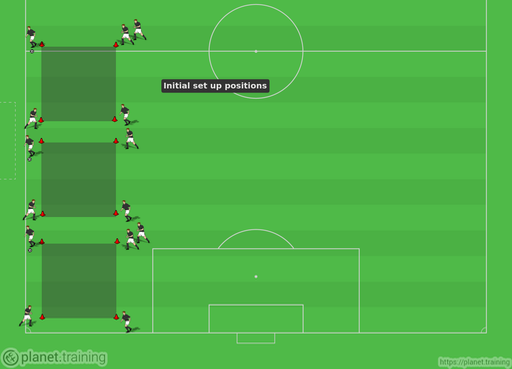
Setup:
Three square grids are set up with 10-yard by 10-yard dimensions with barrier space between each grid. At least one person is placed on each cone and preferably at least one cone in each grid should have two players positioned.
Execution:
Passing occurs in various patterns as described in the diagrams. Each pattern is initiated by passing to the right first and after a determined time the initial pass goes to the left. Coaches must emphasize receiving the ball with the front foot on all activities that involve the ball moving forward. Back passes should be received with the back foot and the body turned sideways on. If there is an extra person on a cone, the extra should apply a little defensive pressure and the attacker should push the defender away with the body and slightly check toward the ball or hold the defender off.
Variations:
Add a second ball to the passing sequence.
For all passes, the players should look over their shoulder before receiving the pass.
For all passes, the passer must call out the pass with one of three terms:
• Back
• Turn
• Hold
Comment
Make six different size Dutch squares. Have players rotate by shifting to next grid over after each sequence left and right direction. Challenge them to do the activity with long and very short passes.
Activity 3: Twenty One (Blackjack)
Main phase
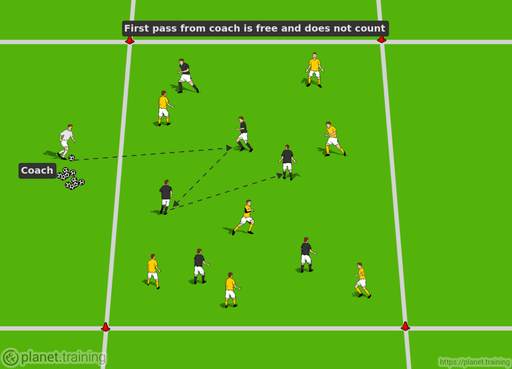
Setup:
Possession oriented play is essential to the modern game of soccer. Many of the activities to develop possession allow for maximum success by giving space for possession or by giving extra attackers to the possessing side. The ability to control the ball in possession in tight spaces is often ignored in training session by prioritizing success and space.
This activity emphasizes possession while having to concentrate and think more than just one step ahead. The athletes will need to move to position themselves for maintaining possession in very tight spaces (much like the full sided game when compressed to a certain portion of the field). This movement and communication necessary under strict pressure of time and space can have a great effect on maintaining possession once the game whistle blows.
Execution:
Two teams of seven players occupy a rectangular grid in any portion of the field. Coach serves the ball to either color team for initial play. Each successful pass is counted in sequence until the score of 21 is achieved. Every ball that goes out of play is left out and the coach starts a new ball without hesitation to the team who did not knock the ball out of bounds. Quick transition to the new ball is essential. Once a total (not sequential) 21 passes is achieved the game ends and the losing side must respond with a consequence such as a series of sideline to sideline sprints and the game resumes. A third team waiting in the wings can substitute for the losing side and begin possession by being served the first ball.
Variations:
Add goalkeepers to the end who can play the ball with either their feet or to the hands (coach's preference) but the pass to the goalkeeper does not count as part of the total completed passes toward the accumulation of 21 passes (see drawing 2).
Activity 4: 5 vs 5 multiple fields
Main phase
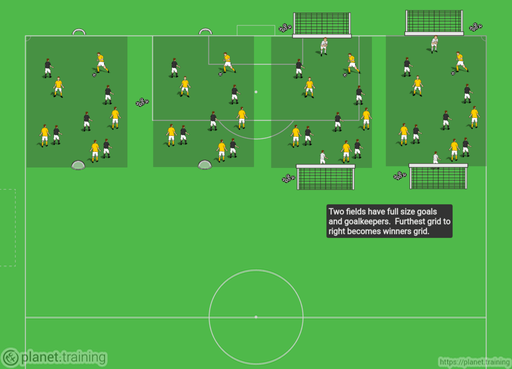
Setup:
Grid size of 30 X 25. Teams divided into groups of 5 for full sided play. For large team settings or camp settings have at least four full size goals for two fields and the rest of the fields can go to mini goals.
Execution:
Teams compete for 3 minutes and score is kept every time. Winners of games are rewarded for their success and if in tournament style can move up to the winners’ field with full size goals. Make it/take it rules always apply. If a team scores, they start off with the possession again. Balls out of bounds are played with a throw-in so that the full elements of the game are used. Corner kicks are required as well.
Variations:
Keepers can only serve to their backs: no long delivery.
Require certain formations depending on emphasis of the training.
Can require that all restarts begin with the GK
Can require that all restarts begin with the coach or server on sideline
Activity 5: Fitness 38's
Main phase
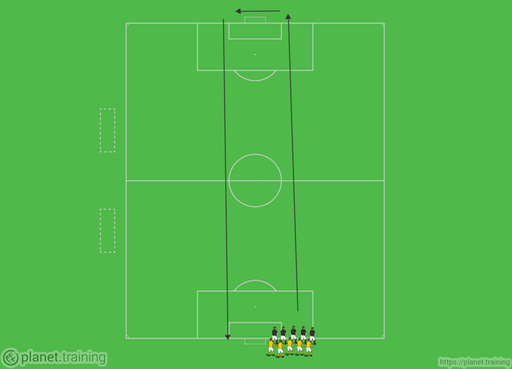
Setup:
Team is divided into groups of 4-7. They line up behind and to the right of the goalpost on full size field (120 in length).
Execution:
On coach's signal with a timer the groups are released one at a time to run around the other goal and return across the end line in 38 seconds. This is not difficult on the first interval but is very demanding by the 4th one. Coach can do as many as the fitness level demands for the age group and level of competition. Each group should be given at least 90 seconds rest between attempts. Ideal time is more in the two-minute rest range.
Coach can send second group when the first group reaches the far goal near post.
Variations:
Reduce the time allowed to cross the line to as low as 34 second and do fewer sets. Do not reduce the rest interval regardless of how many sets.
Comment
We will run 6 of these at the end of training. Groups of 7 people. Do six sets of 38s at end.
Execution:
Full field. Coaches randomly end play with whistle and start a new ball where the coach desires to work on functional play.
By Steven Smith Head Coach at Hope College, Holland, MI


